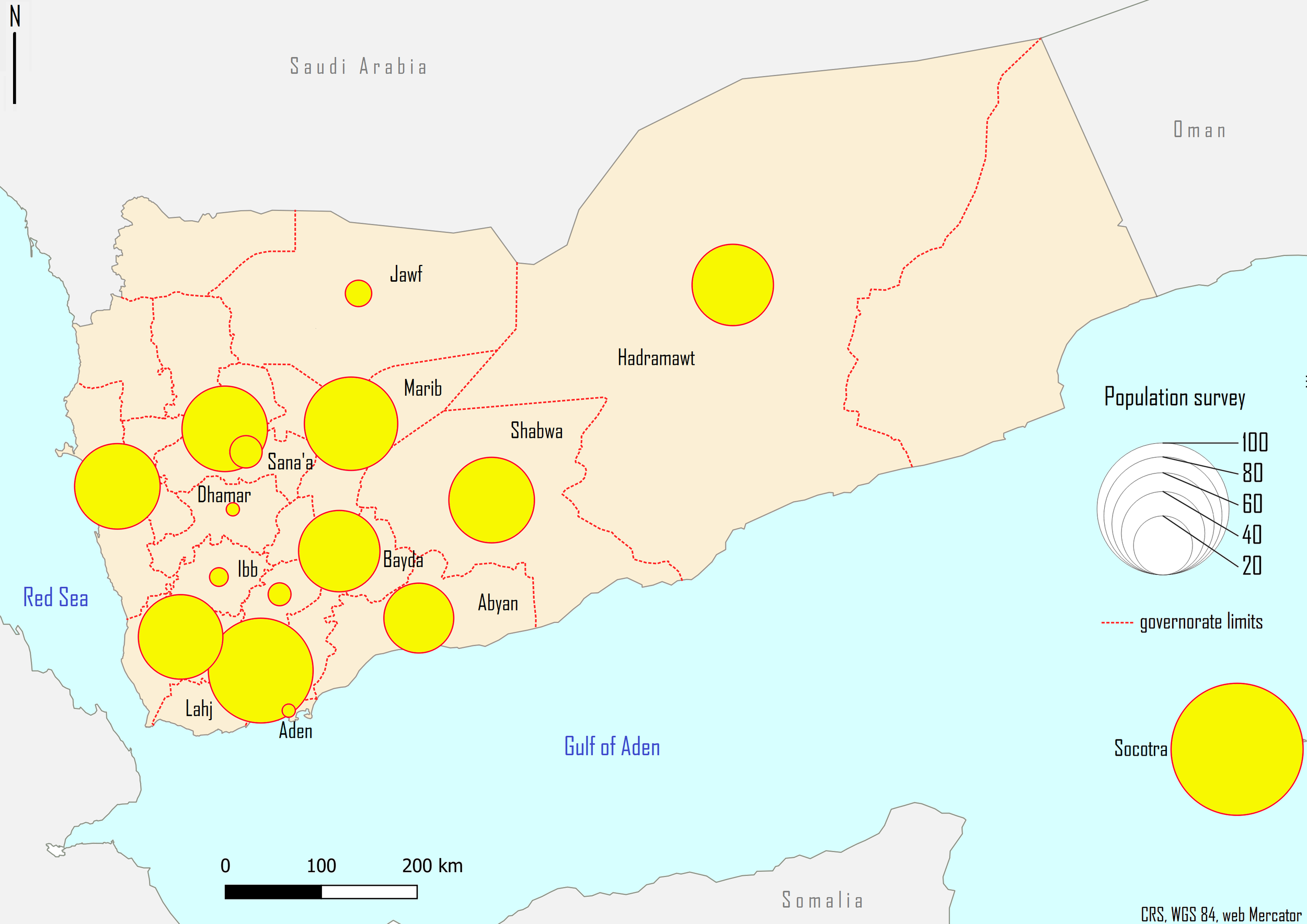Yemen
Yemen has a shoreline of 1,906 km with the Red Sea marking much of its western border, ending in the Bab-el-Mandeb, which connects the Red Sea to the Gulf of Aden. It has a total 527,968 sq km, along with a population of approximately 31.6 million inhabitants.[1] Yemen struggles with various challenges, including high unemployment (13.57%), massive poverty (48.6%) and extreme public debt (74.5% of GDP).[2] Additionally, Yemen is confronted by low annual economic growth (0.8% in 2018; with major dips as low as -28% in 2015).[3]
Yemen’s annual average rainfall is approximately 190mm annually. However, there are distinct differences between rainfall in the coastal areas and the much drier center of the country.[4] Additionally, Yemen struggles with absolute water scarcity, with most recent estimates for renewable internal freshwater resources at only 67 cubic meters per capita.[5] Yemen suffers from a lack of arable land, with only 2.2% of the total land being classified as arable,[6] and less than one percent (0.6%) being cultivated with permanent crops.[7] In terms of energy, although Yemen is not a major exporter of hydrocarbons, it does have its own domestic supplies of natural gas and oil that are sufficient for limited domestic consumption.[8] All of this has taken place against the backdrop of the Yemeni Civil War, which began in 2014, and has witnessed the ongoing political struggle between the Ansar Allah (Houthi) movement and first the government of Abdrabbuh Mansur Hadi, and more recently, the Presidential Leadership Council.
Relative Survey Population Sizes for the Perceptions Survey. Map created by Moustapha Nour-Ayeh.
Yemen’s entrenched structural issues are only exacerbated by the ongoing risks related to climate change. Across the country, the past few decades have seen an average increase in temperature of 0.39°C per decade, with more extreme temperature changes taking place during the summer months.[9] Furthermore, Yemen has additionally witnessed a general trend of a decrease in rainfall of about 1.2 mm per month (-9%), which has serious implications both for sources of freshwater as well as for agriculture, even as erratic rainfall has witnessed flooding during the rainy seasons as well. In terms of agricultural labor, the vast majority of those who work in agriculture are subsistence farmers, and the increase in desertification across the country in recent years has led to approximately a 3-5% loss in arable land annually. The lessening of overall precipitation is also expected to lead to large losses in agricultural productivity.
The increasing temperatures also have a serious effect on the water resources, which are currently in a drastic state as well. Yemen’s capital city of Sana’a is “the world’s most water-stressed city,” [10] due both to the rising population in the area, and the state of the main aquifer providing water to the city, the Arabian Aquifer System, which is currently seeing water extraction at an unsustainable rate.[11] Although Yemen as a state is incredibly vulnerable to climate change, it contributes in a highly limited way to global greenhouse gas emissions, at a rate of approximately 0.07% of the global share.[12] Although Yemen is not an Annex I Party under the United Nations Framework Convention on Climate Change, Yemen has increasingly sought to implement strategies to reduce emissions and promote sustainable energy use on a state level.[13]
[1] “Yemen,” in The World Factbook (Central Intelligence Agency, February 20, 2024), https://www.cia.gov/the-world-factbook/countries/yemen/.
[2] “Yemen.”
[3] “GDP Growth (Annual %) - Yemen, Rep.” (World Bank national accounts data, and OECD National Accounts data files, 2018), https://data.worldbank.org/indicator/NY.GDP.MKTP.KD.ZG?locations=YE.
[4] “Yemen, Rep. Current Climate > Climatology,” Climate Change Knowledge Portal (Washington, D.C.: World Bank Group, 2020), https://climateknowledgeportal.worldbank.org/country/yemen-rep/climate-data-historical.
[5] “Renewable Internal Freshwater Resources per Capita (Cubic Meters) - Yemen, Rep.” (Food and Agriculture Organization, AQUASTAT data, 2020), https://data.worldbank.org/indicator/ER.H2O.INTR.PC?end=2019&locations=YE&most_recent_value_desc=false&start=1990&view=chart.
[6] “Arable Land (% of Land Area) - Yemen, Rep.” (Food and Agriculture Organization, electronic files and web site, 2021), https://data.worldbank.org/indicator/AG.LND.ARBL.ZS?locations=YE.
[7] “Yemen.”
[8] “Yemen: Analysis - Energy Sector Highlights” (Washington, D.C.: U.S. Energy Information Administration, November 13, 2020).
[9] Much of this report is derived from “Climate Change Risk Profile: Yemen,” Fact Sheet, Global Environmental Management Support Project (Washington, D.C.: United States Agency for International Development (AID), February 2017).
[10] “Climate Change Risk Profile: Yemen,” 3.
[11] Hussein Gadain and Brigadier Libanda, “Agricultural Water Deficit Trends in Yemen,” Atmosphere 14, no. 8 (August 9, 2023): 12–63.
[12] “Republic of Yemen: Second National Communication Under The United Nations Convention on Climate Change” (Sana’a, Yemen: Republic of Yemen, May 2013), https://unfccc.int/resource/docs/natc/yemnc2.pdf.
[13] “Republic of Yemen: Second National Communication Under The United Nations Convention on Climate Change,” 63–64.

